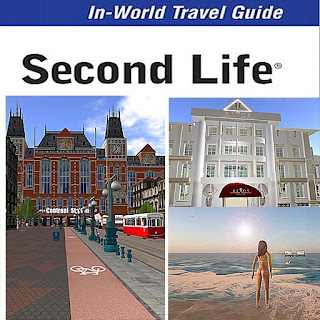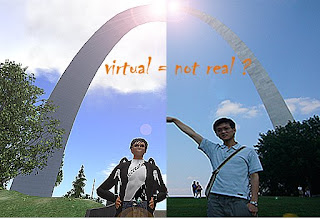Monday, April 27, 2009
what I have learned in the semester
In addition, doing the class projects provides me an opportunity to link with my research interests. For instance, from the project of visual communication of self, virtual identity, I found that the avatars’ appearances can reflect people’s personalities and the virtual experience in Second Life also influences people’s behavior in real world. In addition, in my digital remix project, I have learned how to use images to present my research interest, virtual tourism, and to communicate with others. The digital remix project inspires me to think about the future applications of the virtual world in tourism. Moreover, my film project helps me to explore the issue of social networking and virtual relationships and to think about the impacts of virtual relationships and digital identity on real life. Finally, the web design project provides me an opportunity to look at how markets use the internet as a marketing media to promote virtual destinations. The web site can use various types of visual images like photos and video to communicate as an effective marketing medium.
Both Sturken and Cartwright’s "Practices of Looking," and Kress and van Leeuwen’s "Reading Images: the Grammar of Visual Design" provided me with theoretical grounding for the projects and for my general understanding of the importance of the visual. Every day we engage in looking and seeing to communicate, interact and create meaning of the world. The social worlds in which we live are full of visual images that are designed to be seen with variety of purposes and intended effects. Sturken and Cartwright investigate the meaning of images, which are constructed by social powers, ideologies, and the systems of beliefs and values in all cultures. Images can generate meanings for viewers, yet viewers may interpret the meaning of images differently in particular social and cultural contexts. In addition, they also pointed out that the meaning of images not only depends upon the work itself but is also related to the codes and conventions of the image’s structure, interpretations and experiences of viewers, and the exhibited context of the image.
Sturken and Cartwright discussed the visual technologies and virtual experiences that are related to my field, virtual tourism. The development of digital technologies influences image reproduction and also affects society the way we see the world, and the way we use the image. For instance, from postmodern point of view, “non-space” like Second Life can create virtual identities for online users and provide functions of virtual society, economics, and community that are similar to real world. Furthermore, the avatar represents an actual body in the real world that engages in the social interactions of online space. Conversely, the avatar raises questions about how we think about the impact of virtual reality on real society.
In Kress and van Leeuwen’s “Reading Images: the Grammar of Visual Design,” they discuss the notation of semiotics and sign making. In our society, we use a variety of visual signs to communicate. It is important to know how to use images to denote something to communicate with participants through signifiers (the form) and signified (the meaning). Parallel with Sturken and Cartwright, Kress and van Leeuwen stated that the meaning of the sign is constructed differently across culture. A sign may mean one thing to certain affinity people yet may have an entirely different meaning to different people, while a sign may also have common meanings in different cultures, such as the universal signs that indicate rest rooms. They stated that the image can say the same thing as language. Moreover, Kress and van Leeuwen further discuss visual representations by using linguistic structures, such as narrative representations and conceptual representations. It is interesting to know that the concept and theory used in linguistic structure can be applied in the visual context. Kress and Leeuwen discussed the interaction between the producers and the viewers of the image. Usually the producers are not physically present when the viewers interpret the image, so there is a disjunction of information interpretations between the producers and viewers. In order to make the interactive meanings between the producers and viewers, there are different communicative functions to encode the image visually, such as the perspective of the image, the size of frame, and modality judgments.
After taking this course, I have a better understanding the concept of visual communication. If we want to communicate effectively by using visual images, we need to know who our audiences are, what kind of visual language can be used, where to distribute our visual image, and how to design an interactive visual image. Visual images have great influence on our daily life and can be used in different ways such as telling a story, recording history, entertaining, or expressing ideas. Visual communication can be as powerful an equivalent as verbal communication, and in some instances information presented in visually is much better than verbally. Thus, because in everyday life we use images to express ourselves, to communicate, to learn and to experience pleasure, it is important to know visual communication culture.
Thursday, April 23, 2009
Wednesday, April 15, 2009
Ch 7 & 8
 From ideational function perspective, color can be used to denote people, place and things. For instance Clemson University uses the orange color to signal their identities. Moreover, color also conveys interpersonal meaning and constructs social relation. For example, if people go to watch football game, they will wear an orange Clemson t-shirt to represent their support for tiger team. The authors talk about the semiotic of color from different approach, such as saturation, modulation, purity. In terms of saturation, the higher saturation represent positive, adventurous, and the low saturation represent subtle and repressed. In the modulation, flat color may be perceived as simple, overly basic, simplified, and modulated color may be perceived as subtle, overly fussy, detailed. They stated that “the truth of flat color is an abstract truth and the truth of modulated color a naturalistic truth” (p.234). The semiotic of color should depend on people’s character and social value.
From ideational function perspective, color can be used to denote people, place and things. For instance Clemson University uses the orange color to signal their identities. Moreover, color also conveys interpersonal meaning and constructs social relation. For example, if people go to watch football game, they will wear an orange Clemson t-shirt to represent their support for tiger team. The authors talk about the semiotic of color from different approach, such as saturation, modulation, purity. In terms of saturation, the higher saturation represent positive, adventurous, and the low saturation represent subtle and repressed. In the modulation, flat color may be perceived as simple, overly basic, simplified, and modulated color may be perceived as subtle, overly fussy, detailed. They stated that “the truth of flat color is an abstract truth and the truth of modulated color a naturalistic truth” (p.234). The semiotic of color should depend on people’s character and social value.In chapter 8, the authors discussed the role of three-dimensional visual communication in the visual grammar framework. The visual grammar framework of two-dimensional images can be applied in three-dimensional visual communication but they pointed out a couple difference between them. For instance, the distance and angle between producer and viewer in a two-dimensional image are static, but in a moving image the relationship is dynamic. In other words, distance and angle in most film change constantly, and usually use multiple perspectives.
Wednesday, April 8, 2009
Ch5 of reading images
Moreover, the author talked about the naturalistic critical of the image and claimed that a belief of what is real and what is not on the objective correspondence of the visual image determined visual modality. However, the technology of reproduction creates a new standard for naturalism. Naturalism and realism in today society no longer merge and we need to rethink the role of new image technologies. For example, diagrams, maps and technical images do not seek to present naturalism but these still represent what is real in scientific perspectives. In addition, the author mentioned when the art became intertwined with design, the boundaries between representing reality and constructing reality became blurred.
Saturday, April 4, 2009
Thursday, April 2, 2009
Chapter 4 of reading images
In chapter 4, Kress and Leeuwen discussed the interaction between the producer and the viewer of the image that involves the represented participants and interactive participants. Represented participants are the people, things, and places that depicted in images and interactive participants are people who make sense of images and communicate with each other. Usually the producers are not physically present when the viewers interpret the image, so there is a disjunction between the producers and viewers. The author stated that “the image itself and a knowledge of the communicative resources that allow its articulation and understanding a knowledge of the way social interactions and social relations can be encode in images” (p115). In order to make the interactive meanings between the producers and viewers, there are different communicative functions to encode the image visually. For instance, the size of frame to the choice between close up, medium shot and long shot is one dimension to the interactive meanings of image. The distance also determines the social relations. Through the patterns of distance, people can be portrayed as friends, intimates or strangers.
In addition, the perspective of the image is another way to bring relations between producers and viewers. The selection of an angle implies the expressing subjective attitudes that are social determined. The point of view is the position of the viewer in relations to the image including subjective and objective images (image with or without central perspective). In subjective images, the viewer can see what there is form a particular angle, and in objective images the image reveals everything there is to know. Besides, the horizontal angle and vertical angle convey different relation between the represented participants and viewers. “Horizontal angle is a function of the relation between the frontal place of the image producer and the frontal plane of the represented participants” (p134). The Horizontal angle can encode the meanings of image as detachment and involvement. Moreover, in terms of vertical angle, a high angle makes the subject look small and insignificant, and a low angle makes it looking imposing and triumph (p140). Thus through the angle and social distance, viewer can make sense and relation to the represented participants in a certain way.
Wednesday, March 25, 2009
conceptual representations
In addition, analytical processes relate participants in terms of part and whole structure that involve carrier (whole) and possessive attributes (parts). In analytical process, defining characteristics in specific content is one of the major purposes. For instance, in temporal analytical process, timeline represents the history of the world as successive states with fixed and stable characteristics. We could find that timeline could be used to signify human history by visual means. In dimensional and quantitative topography, chart are drawn to scale based on the quantity of aggregated to distinguish participants such as different socioeconomic groups or landmarks. Furthermore, the authors also talked about symbolic processes that are about what a participant means including symbolic attributive and symbolic suggestive. Symbolic suggestive processes have one participant, the carrier and the participant represent the meaning that coming from within. Symbolic attributive processes represent meaning and identity as being bestowed to the carrier. Thus, from reading this chapter, we could know that the visual image could be used to represent relation between people, places and things.
Wednesday, March 4, 2009
reading images: Ch2
The author pointed out that participants are connected by a vector to represent doing something or a process, and the vector always present in narrative structure. In addition in narrative structure, actors also play an important role and defined as” the participants from whom or which the vector departs” (p.59). There are six kinds of narrative processes which are action process, reactional process, speech and mental process, conversation process, geometrical symbolism and circumstances. “Those narrative processes can be distinguished on the basis of the kinds of vector and the number and kind of participants involved “(p.63).
In action process, when images or diagrams have only one participant, the action is called nor-transactional process that is no goal or aimed. In contradict, in a narrative visual proposition, a transactional process have two participants: one is the actor and the other is the goal. Some transactional structures are non-directional and some are bidirectional. Besides, in reactional process, the vector is formed by an eye line, by the direction of the glance of one or more of the represented participants (p.67). reactional process can also be transactional process or non-transaction process. Furthermore, speech process and mental process is the vector in comic strips. In geometrical symbolism, the meanings of image are constituted by their symbolic value. Moreover, the author mentioned that in circumstances structure, the tools used in action process often represent as circumstances of mean and there is no clear vector between the tool and its user.
In sum, the relation between vectors and participants forms different kinds of narrative process. The visual image or diagrams can represent narrative meaning the same as language.
Thursday, February 26, 2009
Wednesday, February 25, 2009
reading images: introduction & Ch1
A sign may mean one thing to a certain affinity people, may have an entirely different meaning to different people. For example, the following sign have different meanings across countries.
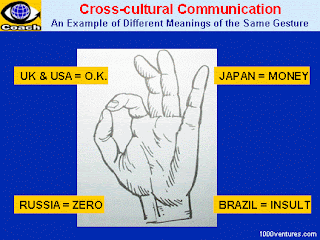
A sign may also have common meaning in different culture such as the signs of rest room. Whenever we travel to different countries, we could easily find the restroom by looking the sign.
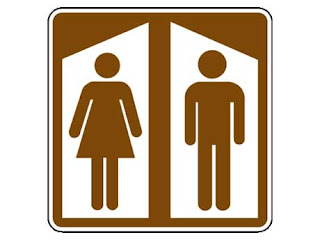
Thursday, February 19, 2009
Ch9-10
In tenth chapter, the author described the global visual culture, and how visual culture contributes to the process of globalization. The image circulated through print media, broadcast TV, and films around the world with the development of satellite and web. Through the communication technologies, the long distance connection facilitates the global flow of visual culture that increases the circulation of concepts, ideas, politics and cultural product. The movement of globalization make possible for people, products and culture to across nation boundaries that result in the trade liberalization and the emergence of global market. The global brands company used local strategies to market their brand differently in different places as an aspect of emergent cultural and national identities in different contexts. Struken & Cartwright pointed out that “two aspects of identity –the global and the local are inter dependent” (p404). With global trade liberalization and cultural exchange in a world moving toward a global village, I was wondering will the development of globalization facilitate the global culture that make difficult to identify national culture.
Thursday, February 5, 2009
avatar appearance
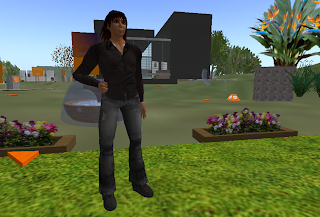
The initial appearance
The initial appearance is an avatar with black jacket and blue jeans including a white t-shirt. He has tattoos in his both arms and a long hair style.
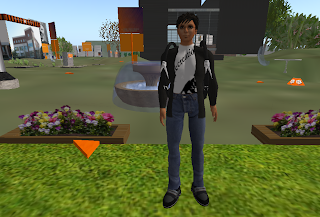
standard avatar appearance
The digital version of my standard avatar appearance showed his characteristics as a digital traveler whose pastime is to travel different place to discover something different to everyday life, something new, worthy seeing site in this virtual environment.
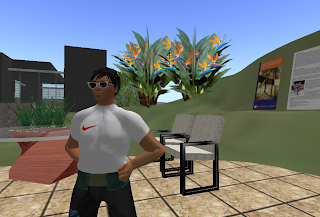
summer outfit
A short sleeve polo shirt made by Nike, a pair of short blue jeans with matched tennis shoes and a pair of sunglassbecomes his summer outfit.
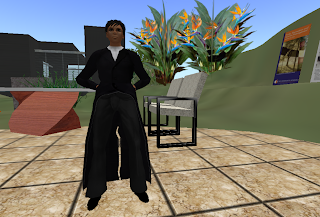
winter outfit
In winter time, my avatar wears a long sleeve white shirt and black formal pants as well as a black overcoat. He always layer two or three when it is cold so he won't freeze.

formal dress
In traditional western style of formal wear, he has a dark black suit and a white formal shirt with a gray tie. The formal dress will be suitable for him to participate in formal social events.
Wednesday, February 4, 2009
ch 7-8
In addition, the author also discussed viral marketing. Advertisers employed marketing techniques to disseminate their brand awareness through consumer’s social network or to sell their products by word of mouth. The product information communicated by word of mouth also has an added layer of credibility. For example, when we decide to take a trip, we search information on the travel blog to get some personal travel experience or we will ask our friend or family members to get some recommendation on our tourism decision making. With the development of computer technology, the online discussion forum or online communities will create new forms of distributing advertising message to target niche consumers. In today consumer society full of commercial and advertising information I am wondering would the viral marketing be more effective than traditional marketing like TV, newspaper, or radio.
In eighth chapter, the author discussed the postmodernism and the relationship with popular culture. Sturken and Cartwright stated that “the postmodern is characterized by the questioning of the supposed universality of structural knowledge as well as skepticism the modern belief in the universality of progress” (p312). In postmodernism, we rethink the traditional paradigm and there is no absolutely truth in postmodernism’s world. Postmodernism remake or rework mass and popular culture as an approach to reflex to our real life activity. Sturken and Cartwright also declared that “postmodern style redefined the notion of authorship and the relationship of production, distribution and consumption that has been enabled by changing technologies and new cultural practices” (p334). Rework or remark became a style of postmodernism to create art and I wonder if the ides of originality in art and the value of true are no longer important for postmodern artist.
In addition, the author also described the growing of digital technologies and virtual experience, postmodern space emphases on the “non-space” like Second Life. Second Life, which is an online world and simulated space, can create virtual identities for user and provide the function of virtual society, economics, and community similar to real world. The avatar represents actual body in real world to engage in the social interaction and activities in online space. How do we think about the impact of virtual reality in social structure of the real world through psychological, and other types of interactions?
Thursday, January 29, 2009
Ch 5-6
In chapter six, media in everyday life, Sturken & Cartwright discussed how the mass media such as TV, radio, web media affect our everyday life and society. Some people believed that because of the rise of mass media, people lose the sense of community and interpersonal life while others argued that mass media provide more opportunity to connect with community and gain more information about local regions. I think that mass media provide privacy sphere for family and the information access to local issue connect to their communities. Moreover, Sturken & Cartwright also described the relationship between media and public sphere. Through broadcast media such as call in talk show, webcast forums, people participated in the discussion of public issue to create a public sphere that could produce social change. In addition, mass media could affect viewer as a part of national audience thinking to foster the sense of national identify. Furthermore, Sturken & Cartwright also talked about the emergence of webcast media. Without going out, people can access local, national, global information to increase the individual experience of the world simultaneously through webcast media. The experiences of global media help us to connect to geographically distant community and people. In tourism, there are a lot of researches going on how the webcast media influence traveler behavior. For instance, the webcast media like travel blog provide information for tourist to interact with others that influences on their travel decision and travel blog also can record what happen in their journey instantly to share with family or friends. For marketing point of view, I am wondering how business applies the power of web media to marketing their products and services.
Wednesday, January 21, 2009
chapter 3 & 4
In chapter four, Sturken & Cartwright discussed the convention of realism and abstract. There is no clear distinction between realism and abstract. The art or representations of realism reflect the truth about society and can reproduce historical meaning in contemporary context. Sturken & Cartwright talked about the role of perspective in visual system to understand that images can perform as not only reproductions of the world but also of ways of seeing and emphasized that “reproducibility in images is not just about the capacity of art works and images to be copied but also about the aim to copy or reproduce the real” (p.143). Furthermore, they discussed the change of convention of realism in the context of digital media. For instance, video game places viewers in interactively creating environment and the players are afforded the experience of seeing as if the eyes of character. Sturken & Cartwright asserted that the term of virtual provides misconception of not real or only exits in imaginations and stated that “virtual reality systems create simulations that attempt to provide an experience in which players feel as if they are physically incorporated into the world on all sensory levels” (P.177). Digital media bring different kinds of perspectives and provide more interactive interactions with viewers. I was wondering comparing to the photographs and films, would the digital media be more realistic.
Thursday, January 15, 2009
Possible theme of 853
practices of looking Ch1 & 2
In chapter 2, viewer make meaning, images can generate meanings for viewers yet viewer may interpret the meaning of images differently from how it is intended to been see. Sturken and Cartwright pointed out the meaning of images not only depend upon the work itself but also related to code and convention of image’s structure, interpretations and experiences of viewers, and the exhibited context of the image. They also asserted that “meanings are the product of a complex social interaction among image, viewers, and context” (p55). In addition, Sturken and Cartwright discussed view interpretations: aesthetics and taste. From aesthetics point of view, the art of work bring people pleasure through its beauty, style or the creative and technical virtuosity that is depend on individual interpretations. Sturken and Cartwright say “Taste is informed by experience relating to one’s class, cultural background, education and other aspects of identity” (p.56). They also stated that “the distinctions between different kinds of taste culture have traditionally been understood as the difference between high and low culture” (p.60). However, later in twentieth century the distinction between fine art and popular culture, high and low taste, which involves the elements of hierarchy and value judgment was criticized and became vague. A question to think about is that how low culture gain social value to become high culture. Moreover, Sturken and Cartwright talked about encoding and decoding. Stuart Hall has proposed three positions of decoding of cultural images and artifacts are dominant hegemonic reading, negotiated reading and oppositional reading. A question come to mind is that if an art of work generate oppositional interpretations to viewers, could the work evaluate as a good work or good art?




